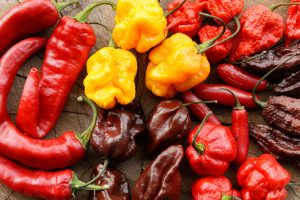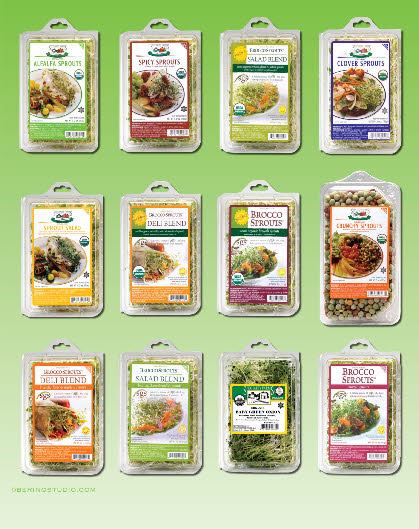Last year someone I didn’t know called me about whether I had heard about people getting Salmonella from peppers. I hadn’t. It was around the same time there were a few recalls:
- Serrano peppers from Warren Produce in Edinburg, Texas
- Habanero peppers from Montero Farms in McAllen, Texas
- Chili peppers from Canada Herb
- Red Thai peppers from Veg-Pak Produce Ltd.
And that FDA had been sampling peppers for Salmonella.
I didn’t think much about it until this afternoon, when CDC published a report in MMWR about a multistate S. Anatum outbreak linked to imported hot peppers.
In June 2016, PulseNet identified a cluster of 16 Salmonella Anatum infections with an indistinguishable pulsed-field gel electrophoresis (PFGE) pattern from four states.* In April 2016, the same PFGE pattern had been uploaded to PulseNet from an isolate obtained from an Anaheim pepper, a mild to medium hot pepper. Hot peppers include many pepper varieties, such as Anaheim, jalapeño, poblano, and serrano, which can vary in heat level from mild to very hot depending on the variety and preparation. This rare PFGE pattern had been seen only 24 times previously in the PulseNet database, compared with common PFGE patterns for this serotype which have been seen in the database hundreds of times. Local and state health departments, CDC, and the Food and Drug Administration (FDA) investigated to determine the cause of the outbreak. Thirty-two patients in nine states were identified with illness onsets from May 6–July 9, 2016.
Local and state investigators visited restaurants where patients reported consuming peppers. They collected recipes for reported menu items, including salsa, and reviewed invoices to identify common ingredients. To identify the source of hot peppers, FDA conducted traceback (the process of tracing a food from point-of-service to its origin or manufacturer source) from three restaurants in Minnesota and Texas where patients reported eating. Two of the three restaurants received peppers from a consolidator/grower in Mexico (consolidator/grower B) (Figure 3), which exported Anaheim peppers to the United States in April 2016. Consolidators pool foods from different growers or growing locations; this designation is also used if some growers/growing locations are unknown.** The third restaurant received peppers from various firms in Mexico; however, this restaurant had received peppers from consolidator/grower B before this outbreak. Because of the complicated supply chain for peppers and the extensive mixing of peppers from different suppliers, repacking, and reselling of product, FDA was unable to identify a single source farm or point of contamination for peppers.
Too bad. Maybe this is what the call was about.



 salsa de tomate, qui contenait aussi les piments, a été conservée au-dessus de 5°C pendant plus de 4 heures et a ainsi augmenté le risque que des personnes soient malades. Les tomates en dés, en tranches ou en purée peuvent fournir un excellent environnement pour des bactéries comme Salmonella de se multiplier. Il s’agit d’une pratique usuelle mais il est risqué de maintenir la salade salsa et le guacamole à température ambiante pendant plus de 4 heures.
salsa de tomate, qui contenait aussi les piments, a été conservée au-dessus de 5°C pendant plus de 4 heures et a ainsi augmenté le risque que des personnes soient malades. Les tomates en dés, en tranches ou en purée peuvent fournir un excellent environnement pour des bactéries comme Salmonella de se multiplier. Il s’agit d’une pratique usuelle mais il est risqué de maintenir la salade salsa et le guacamole à température ambiante pendant plus de 4 heures..jpg)

 If you still have Anaheim peppers, please throw them away. Do not return them to the store. You may go to the service desk for information on receiving a refund.
If you still have Anaheim peppers, please throw them away. Do not return them to the store. You may go to the service desk for information on receiving a refund.
.jpg) Generally, my careful avoidance of them is a fairly unique practice. At least, I thought so until I met Bret. We stand together in our quest for vegetables that don’t leak acid on the rest of the salad.
Generally, my careful avoidance of them is a fairly unique practice. At least, I thought so until I met Bret. We stand together in our quest for vegetables that don’t leak acid on the rest of the salad. Throughout our trip, we ate at cafes, buffets, and casual dining establishments. When we didn’t eat out, we stopped at Wal-Mart for cereal and sandwich supplies. None of those places showed signs of produce being recalled.
Throughout our trip, we ate at cafes, buffets, and casual dining establishments. When we didn’t eat out, we stopped at Wal-Mart for cereal and sandwich supplies. None of those places showed signs of produce being recalled. 
 I was back at superhero headquarters (i.e. in front of my Mac) when
I was back at superhero headquarters (i.e. in front of my Mac) when 